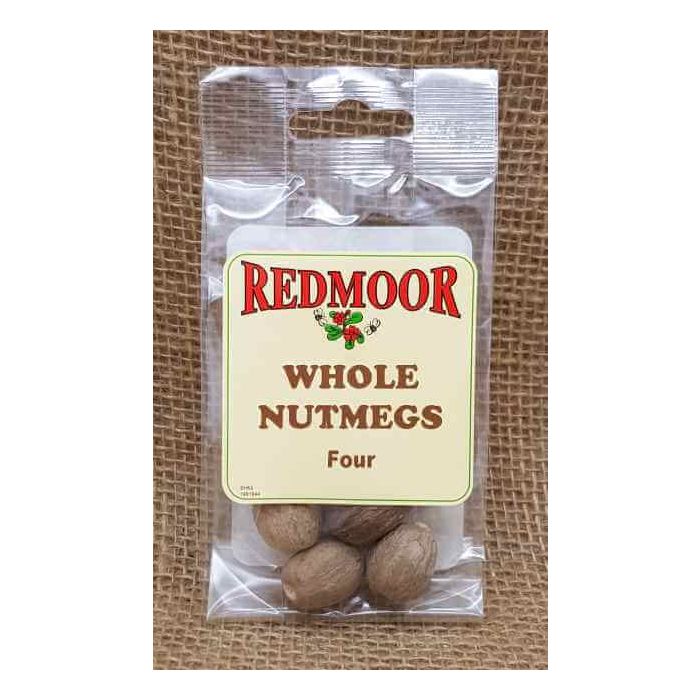NUTMEG WHOLE 4 IN NO.
Login for Pricing
SKU
SH52
RRP : £0.99
VAT RATE : 0%
NUTMEG WHOLE 4 IN NO.
General Description
Nutmeg is the seed of Myristica fragrans, an evergreen tree native to the Molucca Islands. Interestingly, the tree produces both Nutmeg and mace, and grows up to 60 feet tall. Although the tree takes seven years to bear fruit, it may produce until the 90th year. Both spices come from the tree s fruit, which splits into a scarlet outer membrane, mace, and an inner brown seed, Nutmeg.
Geographical Sources
Nutmeg is grown in Indonesia and Grenada.
Traditional Ethnic Uses
Nutmeg is a mild baking spice and is used in sausages, meats, soups, and preserves. Nutmeg is commonly added to eggnog, puddings, and fruit pies. It is popular in The Netherlands and Italy, where it is used in vegetables, puddings, and stews.
Taste and Aroma
Nutmeg is more pungent and sweeter than mace.
History/Region of Origin
The Roman philosopher Pliny wrote about Nutmeg and mace in the first century. Indian Vedic literature recommended Nutmeg for bad breath, headaches, and fever. Arabian writing mentions its uses as an aphrodisiac and stomach medicine. Middle Eastern traders brought Nutmeg and mace to Southern Europe in the sixth century, and they were wellknown by the twelfth century from Italy to Denmark. The Portuguese found Nutmeg trees in the Molucca Islands, and dominated the Nutmeg and mace trade until the Dutch overcame it in 1602. Unaware that the spices came from one tree, one Dutch official ordered the Moluccan islanders to plant more mace trees, and fewer Nutmeg trees. Nutmeg production spread to the West Indies, Trinidad, and Grenada under the British in the 1800s.
Description
Nutmeg is the seed of the fruit which grows on the tree Myristica fragans, the same fruit from which Mace is derived. The oval shaped seeds have a sweet, spicy flavor. When ripe, the fruit splits in half exposing the netlike membrane or aril known as the mace. The mace closely enwraps a dark brown, brittle shell inside of which is the single, glossy, brown, oily seed or the Nutmeg.
Uses
Commonly used in sweet foods and enhances savory foods. Nutmeg blends well with other spices and is found in the ethnic cuisines of Italy, the Caribbean, France, India, Germany, Scandinavia, Greece, Latin America, and the Middle East.
VAT RATE : 0%
NUTMEG WHOLE 4 IN NO.
| Ingredients | Nutmeg |
| Barcode EAN :5028986007498 |
General Description
Nutmeg is the seed of Myristica fragrans, an evergreen tree native to the Molucca Islands. Interestingly, the tree produces both Nutmeg and mace, and grows up to 60 feet tall. Although the tree takes seven years to bear fruit, it may produce until the 90th year. Both spices come from the tree s fruit, which splits into a scarlet outer membrane, mace, and an inner brown seed, Nutmeg.
Geographical Sources
Nutmeg is grown in Indonesia and Grenada.
Traditional Ethnic Uses
Nutmeg is a mild baking spice and is used in sausages, meats, soups, and preserves. Nutmeg is commonly added to eggnog, puddings, and fruit pies. It is popular in The Netherlands and Italy, where it is used in vegetables, puddings, and stews.
Taste and Aroma
Nutmeg is more pungent and sweeter than mace.
History/Region of Origin
The Roman philosopher Pliny wrote about Nutmeg and mace in the first century. Indian Vedic literature recommended Nutmeg for bad breath, headaches, and fever. Arabian writing mentions its uses as an aphrodisiac and stomach medicine. Middle Eastern traders brought Nutmeg and mace to Southern Europe in the sixth century, and they were wellknown by the twelfth century from Italy to Denmark. The Portuguese found Nutmeg trees in the Molucca Islands, and dominated the Nutmeg and mace trade until the Dutch overcame it in 1602. Unaware that the spices came from one tree, one Dutch official ordered the Moluccan islanders to plant more mace trees, and fewer Nutmeg trees. Nutmeg production spread to the West Indies, Trinidad, and Grenada under the British in the 1800s.
Description
Nutmeg is the seed of the fruit which grows on the tree Myristica fragans, the same fruit from which Mace is derived. The oval shaped seeds have a sweet, spicy flavor. When ripe, the fruit splits in half exposing the netlike membrane or aril known as the mace. The mace closely enwraps a dark brown, brittle shell inside of which is the single, glossy, brown, oily seed or the Nutmeg.
Uses
Commonly used in sweet foods and enhances savory foods. Nutmeg blends well with other spices and is found in the ethnic cuisines of Italy, the Caribbean, France, India, Germany, Scandinavia, Greece, Latin America, and the Middle East.
| Hide Price | No |
|---|

